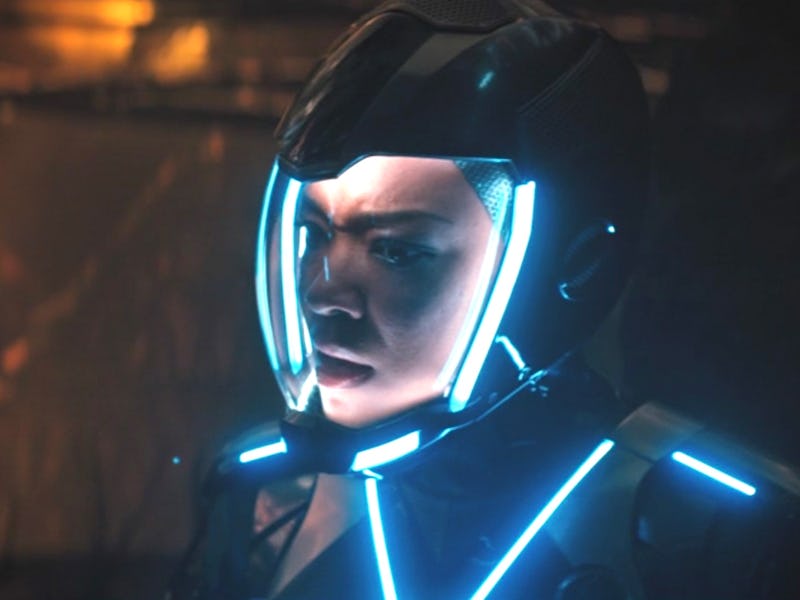With Discovery Season 4, Star Trek canon is finally getting real about aliens
Discovery Season 4 is avoiding all the alien tropes. Here’s why that’s great.

Aliens in science fiction are hard to do well. Most sci-fi franchises avoid the inherent problem of “humanizing” aliens by just not trying. Star Wars and Doctor Who aliens are often just talking animals, while franchises like Dune don’t do aliens at all. Star Trek has always walked a strange line with the idea of “seeking out new life,” because most of the time that new life just looks like humans with bumpy foreheads, wrinkly noses, or pointed ears. But with Star Trek: Discovery Season 4, the franchise is pushing for something that feels new. And in the latest episode, “Rosetta,” Discovery proves that Star Trek can still do big idea sci-fi.
The slow burn of Discovery Season 4 has pretty much focused on one thing: Figuring out why a giant Dark Matter Anomaly is roving through the galaxy and destroying planets. Instead of making this mystery centered on some kind of evil space empire that’s hell-bent on screwing over the Federation, the alien species behind the DMA has been elusive. Starfleet doesn’t even know what to call this extra-galactic species, so they have the designation “Ten-C.”
In “Rosetta,” Discovery reminds us that Captain Michael Burnham (Sonequa Martin-Green) is a xenoanthropologist, meaning her specialty is dealing with alien cultures. We saw a glimpse of this in the very first Discovery episode, in which Burham and Captain Georgiou (Michelle Yeoh) helped an insectoid alien species avoid a drought while keeping their presence hidden. Essentially, Burnham’s training was all about figuring out strange new lifeforms.
But the four seasons of Discovery haven’t given Burnham much time to practice that skill. After battling an evil A.I. called Control, the crew’s biggest challenge in Season 3 was a ruthless crime syndicate called the Emerald Chain. The last time Burnham was given a chance to really connect with a non-humanoid intelligence was in Season 1, when she was able to figure out what was going on with Ripper, the mutated tardigrade who was able to power the ship’s Spore Drive.
After a long time of sidelining Burnham’s science fiction superpower, Discovery is headed back toward ruminative and thought-provoking sci-fi. In “Rosetta,” the crew find the remains of what appear to be members of Ten-C, giant aliens who perhaps swam around in the clouds of gas giants. Burnham also deduces that they communicate through a series of pheromones embedded in a specific kind of dust. This rules out a spoken language and telepathy, meaning Ten-C probably communicates emotionally, through a substance that a human would regard as useless.
Cubler, Detmer, Burnham and Saru explore a truly strange, new world.
All of this leads the crew to a half-victory. They now have some basis for understanding how to communicate with the Ten-C, but they still lack a basic understanding of intent. At the end of the episode, Burnham contemplates the notion of having empathy for a species that may not have any empathy for the Federation. Just because they can maybe communicate with the Ten-C, that doesn’t mean these gas-cloud dwelling creatures share any of their values.
Discovery is allowing for the notion of alien intelligence to be discussed on the show without offering easy answers. Morality is a human construct, and to assume that aliens beyond our galaxy share our idea of morality is tricky. Burnham is buoyed by the idea that these creatures seem to care about protecting their young, but Saru points out that the Ten-C still might not “care” about the Federation.
It’s heady stuff that recalls some of the better moments in The Next Generation, Deep Space Nine, and Voyager, as well as great science fiction novels like Arthur C. Clarke’s Rendezvous With Rama. Instead of trying to make the alien species a mirror for humanity, Discovery is attempting to construct science fiction explanations for how an alien species could exist despite not being like humans in the slightest. This may seem like an obvious route, but when you consider how difficult is to realistically portray something that’s truly unknowable, you suddenly realize why so many aliens in sci-fi have arms and legs.
The Ten-C may end up having tentacles or some other alien trope we’ve seen before. But what Star Trek: Discovery has done this season is positive for modern science fiction. Instead of rushing to show us the aliens, the series has reminded us that thinking about aliens is just as interesting as meeting them.
Star Trek: Discovery Season 4 has two episodes left, which air over the next two Thursdays on Paramount+. Here’s the full schedule of Star Trek shows for 2022.